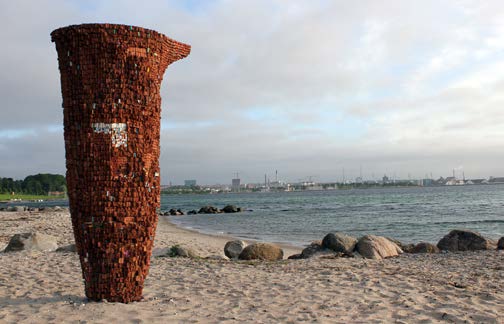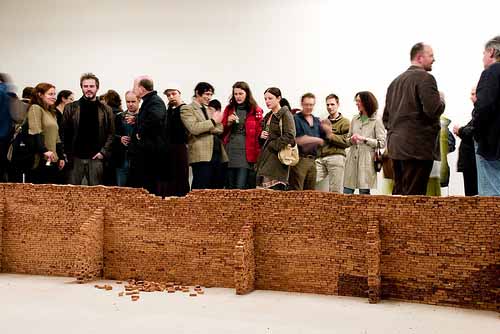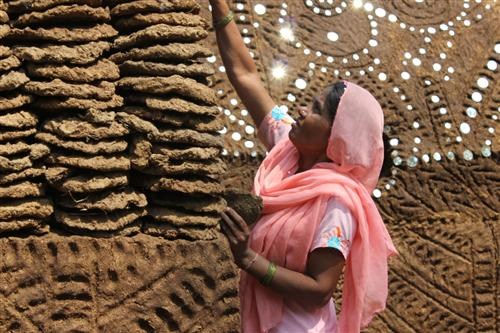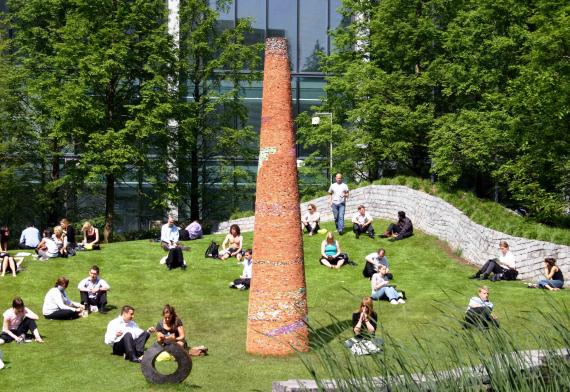Challenging the disciplines: generating creative exploration and public dialogue between sculpture, architecture and craft
Submitting Institution
Newcastle UniversityUnit of Assessment
Art and Design: History, Practice and TheorySummary Impact Type
CulturalResearch Subject Area(s)
Studies In Creative Arts and Writing: Film, Television and Digital Media
History and Archaeology: Curatorial and Related Studies, Historical Studies
Summary of the impact
Andrew Burton's practice-based visual arts research, presented through
international public exhibitions, commissions, illustrated lectures,
conference presentations and publications has impacted on international cultural
life and public discourse around the creative intersection
between the worlds of sculpture, ceramics, architecture and craft. This
research has:
a) provided opportunities for public audiences to experience unique
artworks which embody and combine an articulation of fine art and craft
sensibilities, methods and skills;
b) stimulated practitioner-led debate around the relationships between
the practices and educational disciplines of sculpture, ceramics,
architecture and craft.
Underpinning research
Andrew Burton is Professor of Fine Art and has been employed at Newcastle
University since 1986.The focus of this impact case study is on his
practice-based explorations into the relationships between sculpture,
ceramics, architecture and craft particularly on his body of research into
the use of ceramic brick in sculpture and his work with artisans in India.
Burton's work explores the links between materials and their wider social
and cultural uses. In using low value, locally sourced materials and
hand-made production processes his work explores the (assumed) division
between `artist' and `artisan', and questions our (Western) approach
towards the way objects are made. Burton's research outputs are
concentrated on the creation of unique sculptural artworks and their
public display in group and solo exhibitions and as public realm
commissions. The reach and significance of this research is evidenced by:
the international profile of Burton's projects; inclusion in national and
international exhibitions; award of prizes by international juries;
invitations to give lectures and present at conferences in the UK and in
Europe; monograph and catalogue publications; and articles about his work
in influential art, architecture and crafts magazines.
 Jug, 2013, Aarhus, Denmark
Jug, 2013, Aarhus, Denmark
 Harker's Wall, 2007, Newcastle upon Tyne
Harker's Wall, 2007, Newcastle upon Tyne
Since the mid 2000s Burton's research has investigated the nature of
material objects and the industrial and artisanal processes of making.
Many of his works, such as Harker's Wall (1) (pictured
above right) are manifested as temporary structures, built from recycled
components of earlier works, presented on both an architectural and
miniature scale. Burton's research in this area was developed during
artist residency experiences at the Sanskriti Foundation in New Delhi,
India (1) (supported by grants from Arts Council England and the
British Council) and at the European Ceramics Work Centre (EKWC), an
international interdisciplinary workplace for artists, designers and
architects in The Netherlands. This research has led to the production of
a series of temporary time-based installations and permanently sited
sculptures (2, 3, 4), exhibited at venues in the UK and abroad,
including Dutch Design Week (Eindhoven, 2009), the 2008 World Congress of
Archaeology (Dublin, 2008), `Art in the Workplace' programme at Canary
Wharf, London (2008), the 2010 World Expo in Shanghai, `S'Imbriqure: Les
Autours de la Brique', (Beauvais, France, 2011), the National Crafts
Museum, Delhi (2011) at the Centre for European and Chinese Art, Xiamen,
China (2011) and Sculpture by the Sea, Aarhus, Denmark (2013) (pictured
above left). Some works are now permanently sited, e.g. Chimney,
as part of the Canary Wharf public art collection. In contrast, and
demonstrating Burton's recycling approach to materials and construction,
his second work for the Canary Wharf `Brickworks' show, Cathedral
was dismantled and remade in new iterations for the 2009 British Ceramics
Biennale (Stoke on Trent), Contemporary Ceramics (Vallauris, France 2010),
where it won the prize for sculptural work, and most recently for the
Begehungen Arts Festival (Chemnitz, Germany, 2012).
To further explore the way bricks are treated as ubiquitous objects in
the public domain, Burton has collaborated with street artists and museum
visitors in the UK, Korea and Canada. This was evidenced internationally
in the temporary installation Enclosure commissioned for ClayArch
Gimahae Museum, Korea 2008), and Buttress, (Kitchener,
Canada, 2011) (5). In these works local people were invited to
make their own interventions into Burton's work. Here, graffiti, more
usually seen as a symptom of a dysfunctional cityscape, became an integral
ingredient of the work, adding an extra gestural and colourful element to
the tactility of the brick.
References to the research
2) Making Bithooras a collaborative project developed at
the National Crafts Museum, New Delhi featuring `bithooras' — cow dung
structures made by village women in Delhi http://www.axisweb.org/p/andrewburton
| Awarded to |
Grant Title |
Sponsor |
Dates |
Value |
| Andrew Burton |
Moonwalking, Connections Through Culture (India) |
British Council |
Mar 2010-Mar 2011 |
£5,000 |
| Andrew Burton |
Brickworks — Canary Wharf |
Arts Council England (Grants for the Arts, Individual) |
Nov 2010 |
£5,000 |
| Andrew Burton |
Sculpture from a Land of Ants and Bees |
Arts Council England (Grants for the Arts, Individual) |
Jan 2006 |
£5,000 |
Details of the impact
Burton's research has helped to stimulate public and practitioner debate
around the connections between sculpture, ceramics, craft and
architecture. The research has had a worldwide reach, achieved through the
public exhibition of artworks and through Burton's contribution to
practitioner focused workshops and conference presentations. His work has
reached large audiences, enriching their cultural experiences and has
engaged niche communities, such as bamboo breakers and dung workers
(pictured left) in India whose practices reach new audiences through
public exhibitions.

Impact on cultural life: public opportunities to experience forms of
new artistic expression Burton's artworks make an explicit physical
and visual connection between craft (e.g. brick as a form of fired
ceramic/ bamboo weaving), architecture (brick as a ubiquitous building
material) and sculpture. These qualities of Burton's work have been
highlighted by The British Council which states: "[Burton's] projects are
a response to the materiality of the world. By using commonly found and
low value objects and substances such as brick, dung or bamboo to build
simple structures, often architectural in appearance, but on an unexpected
scale, we are invited to look again at the world immediately around us." (http://creativeconomy.britishcouncil.org/people/andrew-burton/).
The poetic materiality of Burton's art works has also been explored by
architectural journalist Robert Such in his (2009) article for Art and
Architecture Journal. Such writes: "Jug, as with Burton's other
artworks created from the debris of former sculptures, embodies a sense of
continuity with the past, whilst at the same time signifying the
inevitable decay of its surroundings. Works such as this also point to
ways of recycling demolition material into the new fabric of a city,
leaving its visual traces there to remind us of a site's history prompting
perhaps even personal memories, and the experiencing of a sense of
belonging to a place" (IMP1). The importance of Burton's
sculptural investigation of material `decline and regeneration' has also
been highlighted by maker-curator Helen Carnac, in her online showcase of
artists `Making and Unmaking, Repair and Repetition', commissioned by the
major UK visual arts practitioner's website Axis (http://www.axisweb.org,2010).
This online exhibition was subsequently selected as one of 21
Axis highlights for its 21st Birthday year 2012 (IMP2).
In creating artworks for public presentation in urban sites and
exhibition venues across the world: in Asia, North America and Europe,
Burton's works have carried this distinctive sculpture-architecture-craft
dialogue to a large public, within and beyond the traditional arts
audience. Many of these are publicly sited works, where audiences, both
deliberate `visitors' and regular passers-by are invited to touch and
experience the sculpture in a more direct way than a gallery-based work.
Burton's sculpture Chimney is permanently sited at Westferry
Circus, Canary Wharf, London, as part of the award winning Canary Wharf
public art collection. With around 100,000 people working at Canary Wharf
every day this work has been seen and experienced by many thousands of
people since 2008. In an email to Burton, one viewer commented on her own
personal enjoyment of this work: `I saw [your work] on a very wet day with
dark grey skies but with the park looking wonderfully green and acting as
an exciting backdrop to the rich terracotta of your sculptures.' (IMP3,
IMP4).

In `Ceramic City — Design for Public Space' (Stoke-on-Trent, Oct-Dec
2009) Burton's work was exhibited as part a major city-wide festival
celebrating and showcasing contemporary ceramics from across the world.
The exhibition of Burton's work was visited by a public audience of
10,000+ (http://www.britishceramicsbiennial.com).
Burton's work Jug, won one of the festival's Public Art Awards.
His work was featured in a four-page article and used as the back-cover
image for the special ceramic biennial issue of Art and Architecture
Journal (Autumn 2009) (IMP5).
Burton's work Bittern was commissioned for the Environmental Park
at the Shanghai World Expo `Better City — Better Life' (2010).
While exact viewer figures for publicly sited artworks are unattainable,
the Expo overall attracted a record breaking 73m visitors over its 184
days, the majority being Chinese visitors (http://english.eastday.com/e/111001/u1a6133087.html).
The value of Burton's interdisciplinary contribution to the fine art and
crafts field is further evidenced by the inclusion of his work in a
variety of contemporary visual arts publications. These include: reference
to Burton's sculptural ceramics in the survey work `Contemporary Ceramics'
(2009) by the highly respected crafts writer and critic Emmanuel Cooper, a
publication reviewed as "an essential work" (The Sunday Telegraph) and "a
sourcebook of the highest caliber" (Crafts Magazine) (IMP5); `Out
of India' a four page feature on Burton's Indian inspired works written by
Robert Such for the international ceramic art and craft magazine Ceramic
Review (Jan/Feb 2010. Readership: 40,000 per issue) (IMP6);
inclusion in `Ruby: Other Wordliness' (2011) a survey of contemporary
artists working at the cross-over of art and culture compiled by
Argentinian artist-curator Irana Douer (IMP7); and a four-page
interview with Burton in the French catalogue publication `S'imbriquer —
Autour de la Brique' (Artists and Bricks) (2011) (IMP8).
Impact on public discourse: stimulating practitioner-led debate within
fine art, architecture and craft
Burton has been invited to lecture on his work internationally and is an
active contributor to international fine art and ceramics conferences and
symposia, being invited to present his projects and to share his research
and working practices with arts and crafts practitioners in the UK and in
Europe. Presentations have included:
- `Sensuous Knowledge: Reflection, Relevance, Responsibility' (Bergen
Art Academy, Norway, 2009) a three-day annual gathering of 85
practitioners. Here Burton's research on ceramic brick as a sculptural
medium was shared as a case study with artists and curators seeking to
evaluate new routes for artistic research and development. http://sensuousknowledge.org/gammel/category/sk6/
- The conference `Ceramic City — Design for Public Space'
(Stoke-on-Trent, Oct 2009) presented as part of the British Ceramics
Biennial. Here Burton contributed to the conference session `Guerrilla
Ceramics - The ecology of the ceramic object - Political ceramic
statements'. The YouTube video (www.youtube.com/watch?v=qIF2zGMKIA8)
of Burton's talk has received 588 views (to date).
- The ceramic industry conference `European Ceramic Context' (Bornholm,
Denmark, 2010). A major international gathering of ceramics and glass
practitioners and researchers, this conference addressed the situation
of ceramic art and ceramic artists in the present cultural and
industrial economy. Burton's conference presentation 'Making Bricks'
considered basic methods of brick production in India showing how this
had inspired a contemporary sculptural language. www.europeanceramiccontext.com/events/conference/
- `Artification: Ideas and Practice' (Helsinki, Finland 2012) a
three-day conference exploring the growing hybridisation of arts and
social practice. Burton's presentation his work in India contributed to
the debate by highlighting some of the ethical and creative
considerations involved in cross-cultural practice.
www.artification.fi/conference2012.html
- Marking the line: Ceramics and Architecture' (London 2013) a symposium
exploring the relationship between ceramics and architecture in the
context of the exhibition `Marking the Line' at the Sir John Soane
Museum, London chaired by Glenn Adamson.
Burton has also received invitations to contribute to many arts research
and education initiatives. These include invitations from: Clare Twomey
and Edmund de Waal to speak at the conference `Collaboration — research in
ceramics now', University of Westminster Ceramics Research Centre (June
2010); five academis in Belgium, including the Academy of Visual Arts,
Mechelen, to present his research as part of a project on architectural
ceramics, `Architec-Tour' (2011-2013); the Gerrit Rietveld Academie,
Amsterdam to lecture on his work in India to a joint group of architecture
and ceramics working on a collaborative and experimental brick project (IMP9).
Sources to corroborate the impact
(IMP1) Such, R. (2009) `Andrew Burton: Bricks and the City'. Art
and Architecture Journal (Autumn, 2009), pp.24-27 (& cover
illustration).
(IMP2) Carnac, H. (2010) Making and Unmaking, Repair and
Repetition. Available at: http://www.axisweb.org/atSelection.aspx?SELECTIONID=20443.
(IMP3) Link:
http://www.canarywharf.com/aboutus/Media/News/Public-Art/
(IMP4) Email to Andrew Burton, 30.05.08 (Elizabeth Guest).
(IMP5) Book: Cooper, E. (2010) Contemporary Ceramics.
London: Thames and Hudson. ISBN 978-0-500-51487-0.
(IMP6) Feature article: Such, R. (2010) `Out of India'. Ceramic
Review (Jan/Feb 2010). Print copy available on request.
(IMP7) Book: Douer, I. (2011) Ruby: Otherworldliness.
Berlin: Gestalten, Berlin. ISBN 978-3-89955-343-7. Print copy available
on request.
(IMP8) Catalogue publication S'Imbriquer: Autour de la Brique,
(2011) Milan: Silvana Editoriale. ISBN 978-8836620876. Print copy
available on request.
(IMP9) Copies of private emails containing feedback on these
events are available on request.